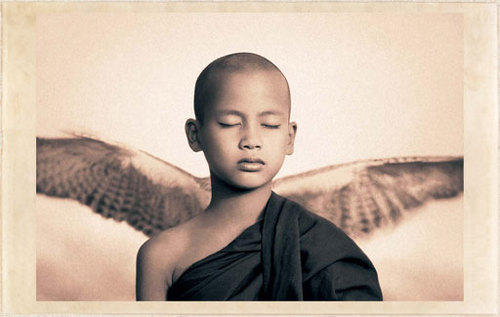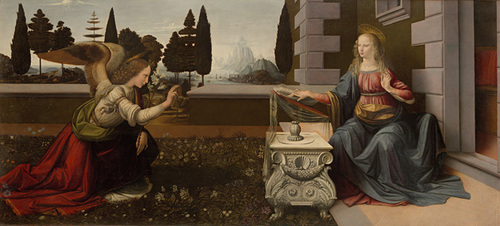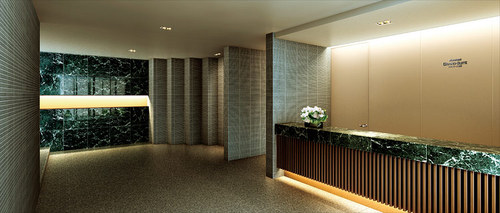We splurged on an Imperia pasta machine for Christmas. It was a good investment - we’ve been enjoying making our own spaghetti, fettuccine and ravioli nearly every week.
The basis of a good pasta is the dough. This semolina and egg recipe never fails to make excellent dough that can be rolled and cut by machine or by hand. It’s yolky yellow, with a chewy tooth and firm texture. It’s such a joy to work with that I hardly every make anything else. And since it’s usually just me and Tod, I make the whole recipe but freeze half the dough for another night. The frozen dough thaws quickly and rolls out like it was freshly made. Honestly, this is the perfect pasta dough.
Perfect Pasta Dough
makes 4 servings
125 g all-purpose flour
165 g semolina flour
3 eggs
1 Tbsp olive oil
pinch salt
Combine the flours and form them into a mountain on your counter. Poke a deep well into the center. Crack the eggs into the well and add the oil. Use a fork to whisk the eggs and oil, slowly incorporating the flour into the mixture. When the mixture gets thick, abandon the fork and use your hands. Knead for ten minutes, then wrap tightly in plastic warp and allow to rest for 30 minutes. (This is a just enough time to tidy the kitchen and get a sauce started!) To finish, roll out by hand or with a machine and cut into desired noodly shapes. Boil in salted water 2-8 minutes, depending on how thick the noodles are and how al dente you like them.
If you’re staggering around Shinjuku as dawn breaks, or just awake at 6 am (or anytime until noon) and looking for an unusual place for Sunday brunch, come over to Araku in Shinjuku’s Golden Gai. The local shopkeepers’ association is having a flea market and some of the bars are staying open for breakfast.
Ours will be the best brunch on the block, I’m certain. Tracey, Ashley and I will be manning the bar and kitchen. Have a bloody mary and some meat pies, or a mimosa and an omelette, or go all out and cure your hangover with Vegemite on toast.
For a map and more info, visit the Araku website
Saturday began the campaign period for local elections throughout Japan. The Bunkyo-ku council elections will be held next Sunday. There are 34 seats and 45 people running according to the big poster-covered signboard down by the station.
Tod & I stopped to read all the campaign posters. They were interesting. Lots of raised fists (a symbolic “I’m trying hard” pose), many smiling faces, one guy shooting hoops and another in his karate gear. Most were vertical posters, but 5 or 6 renegades designed theirs in landscape orientation. Colors are similar to American campaign posters - strong shades of blue, yellow, red and green. One was orange. In addition to party logos, some candidates have their own personal logos, especially the 13 women running: a red tomato, a four leaf clover, a shrimp. Some candidates listed their ages: 30 years old, 25 years old. One claimed ‘I have been working for my community since I was a baby.”
Each and every one of the candidates seems to have a minivan fitted out with loudspeakers. They are driving around town announcing their candidates’ name and asking people to vote. From where I sit, I can hear overlapping echoes of competing trucks and an occasional direct hit as one cruises up our street.
Just around the corner from us an incumbent candidate, Shiraishi Hideyuki, has taken over a derelict shop as his campaign headquarters. When I walked past at lunchtime, he was standing under his awning, looking youthfully political in a suit and a white sash with his name and campaign slogan hand lettered on it. He bowed politely to a crowd of older women huddled under umbrellas in the rain. He said something and they giggled like schoolgirls.
Shiraishi-san is a member of Shinsei Club, a political faction. Of our 34 current councilors, 9 are affiliated with Shinsei Club. I can’t find out much of anything about it, except that it seems to be quite popular among city-level officials across the country.
I like the diversity of political views in our town. Bunkyo-ku currently has 6 Communist council members, 5 members of Japan’s ruling party, the LDP, six Komei affiliates, three in Shimin, and two independents. You can take a peek at their pictures and profiles on the Bunkyo-ku website.
Since I can’t vote, I’m going to grab my earplugs and try to get some work done. Good luck to everyone who is running.
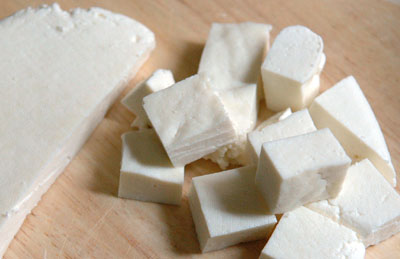
Pressed cheese ready for curry
Cottage cheese is a simple thing to make - they don’t call it cottage for nothing. It takes a bit of your attention, to ensure the milk doesn’t scorch or boil over, but other than that, it’s almost as easy as boiling water.
You need only two ingredients: whole milk and an acid like lemon juice or vinegar. Your yield will be about 15% of the weight of the milk. So a liter of milk makes about 150 grams of cheese and a gallon of milk makes a little more than a pound. The cheese will have a faint taste of the acid that you choose - lightly lemon-y if you use lemon juice. Of course you can season it with herbs or spices as you like. Do that after the cheese is drained.
Cottage cheese can be pressed to make a firm paneer for curries, or left in curds like Miss Muffett always liked.
Cottage Cheese
makes about 150 grams
1 liter whole milk
an acid: 1/2 lemon or lime, juiced, or 1-3 tsp vinegar
cheesecloth
Bring the milk to a boil over medium heat, stirring to prevent scorching. When it comes to a boil, stir in the acid and cook for another 2-3 minutes. The solids will clump together (curds) and the remaining liquid will become a thin watery white (whey). Turn off heat and allow to sit a few minutes to cool.
Strain through cheesecloth (or thin cotton cloth). When the liquid is mostly drained out, lift the cloth by the corners and twist to squeeze out remaining liquid. This is cottage cheese.
To make firm paneer, press the cloth-covered cheese under a 5kg/10lb weight for up to two hours. I usually fold the cloth around the cheese, press it into a pancake shape, sandwich it between two cutting boards, then balance the bowl of whey on top, adding water to increase the weight. After an hour, the cheese is firm enough to cut into cubes.
Over on swap-bot, I joined a round robin journal swap. Each participant decorates a notebook and then pass it along to her partner who adds some pages and passes it along again. Each journal makes its way around the circle and after two or three months you get yours back with nine other people’s art and entries.
I made a little hand-bound, linen covered journal that I sent to Belgium (but forgot to photograph). On Saturday, I received a painted & collaged sketchbook from Sweden. The Swedish journal had a theme of “seeking truth” so for my page, I drew this:

From the photographs of the other participants’ journals I’ve seen so far, most people create multimedia collages. My pen and watercolor stuff seems flat in comparison but it’s what I like to do. I’m a little anxious that simply drawing isn’t satisfactory in this case. I’ve never gotten the hang of collage craft. Still, perhaps I should have sprinkled it with glitter or glued ribbon to the page.
Truth is: the more variety in these journals the better. I should be happy with my contribution and not worry if it’s acceptable to others or not. But the truth is: I feel artistically inadequate.
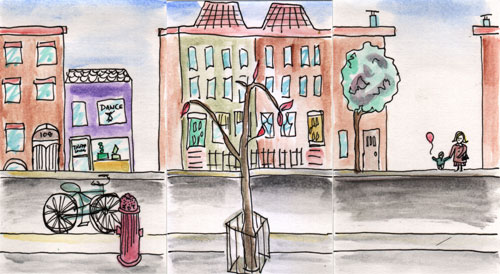
An urban myriorama of three cards. Click to see another arrangement
A myriorama is a panorama made of little cards that can be arranged in any order - the “endless landscape.” They were popular in the early 19th century. I was playing around with a reproduction of one today and decided to try making my own. It was so much fun, I thought you might like to try it, too.
Download a printable tutorial: How to Make a Myriorama 296 KB PDF
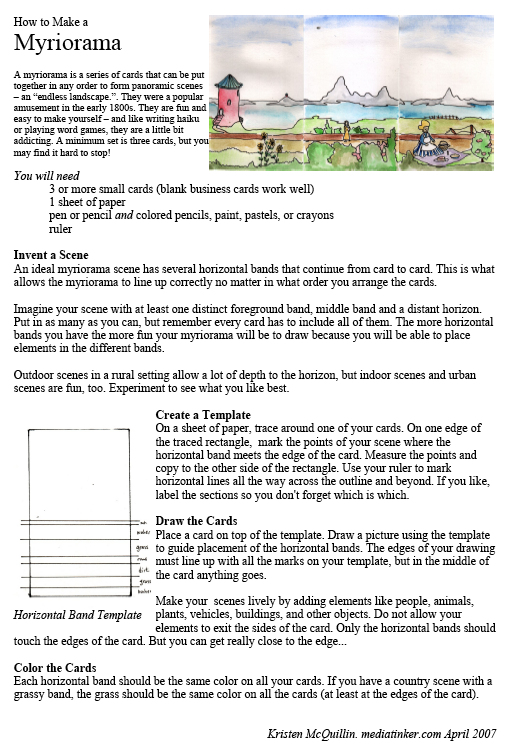
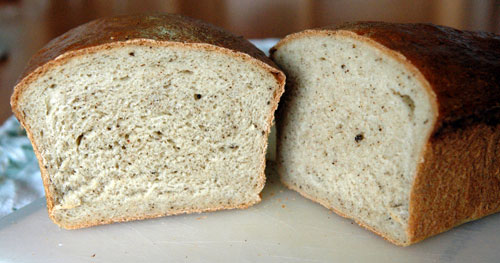
This bread is a variation on my basic white bread recipe but the addition of tea and spices transforms it into a completely different loaf. The spices bring out the honey flavor, the tea makes it interesting. Delicious as breakfast toast, I’d hoped to fry some up some as French toast, but we ate it up before I had time to try!
Chai Tea Bread
makes 1 loaf
100 g bread flour
200 g all-purpose flour
1 c warm milk
1.5 Tbsp hot water
1 pkt instant dry yeast
2 Tbsp honey
2 Tbsp oil
1 tsp Assam tea leaves
2 tsp masala chai spice (a mix of cardamom, ginger, black pepper, clove, mace & nutmeg)
1 egg
Mix milk, water, honey and tea. Add yeast and proof for 5-10 minutes. Mix flour and spices. Add yeast mixture and oil to flour and stir. Turn dough out onto a floured surface and knead about 10 minutes or until the dough passes the windowpane test. Place in an oiloed bowl, cover and allow to rise in a warm or room temperature place until doubled. Shape into loaf pan, rise again for an hour. Wash with beaten egg. Bake at 180C for 30 minutes.
Ashes & Snow is a photography and film exhibit in a temporary building at Odaiba. Gregory Colbert has a vision and he’s spent years travelling the world capturing interactions between people and animals: monks and elephants; a dancer and a hawk; women and anteaters. Sounds strange? It is, but so quiet and meditatively wonderful, that I cried pretty much the entire two hours I was there.
The photographs are printed huge and hanging in space forming the walls of the corridors that lead to and from the film. They are not labelled, inviting you to actually look at them and figure them out. I took my time with them, and was rewarded with echoing patterns and little surprises hidden in reflections. Although the 60 minute film, which is related to the photographs, feels a little too contrived, it was so beautiful to watch that the moment after I started drifting off and thinking “OK, this is going to be over soon, right?’ or “How did he manage to do that?” i was pulled back into the moment by a new and beautiful scene. Personally, I think he could have cut out some of the repetition of similar scenes in different locations, but really, that’s a small editorial niggle.
The temporary museum structure is breathtaking, too. It’s vast but clever lighting arrangements make it feel cozy. A contradiction built of cargo containers, tenting and cardboard.
In short, you must go to this one. It runs through June 24th in the parking lot near Venus Fort and Decks at Odaiba.
The Mind of Leonardo - Universal Genius at Work is showing at the Tokyo National Museum. I got a free pass from a friend who works at the museum and spent an enjoyable hour and a half exploring.
The first part of the exhibit is a single painting - the Annunciation, the first painting completed by Da Vinci after his apprenticeship. He was in his 20s. It’s a lovely painting, more beautiful close up than far away, but you don’t get to spend too much time with it as you and everyone else shuffle past in a slow queue. But getting up close is totally worth the line, though I was there on a day when it wasn’t too busy. I suspect that on a weekend, the wait might be intolerable.
The second part of the exhibit is in another building entirely and it tries to take a holistic view of Da Vinci’s thinking and philosophy. Although he studies and worked in many disciplines - motion, anatomy, painting - he didn’t think of them as different things. They were all interconnected. That didn’t seem like a major revelation to me, but then I dabble in different things and I know they for me they are interconnected, so why not for DaVinci, too?
I particularly enjoyed looking at some of the Codex that was on display. It reinforces my idea that you should keep notebooks and journals and record your ideas in them. His were greatly interesting and surprisingly not beautiful works of art, but working sketches and notes. They looked very little different from things I’ve seen in my friends’ Moleskines.
The exhibit included were numerous video explanations of things - simulations of how his inventions would have worked and his ideas on anatomical geometry were quite illuminating and entertaining.
If you’re interested in a well-presented multi-disciplinary exhibit, this one is for you. Runs through June 17th at the Tokyo National Museum in Ueno.
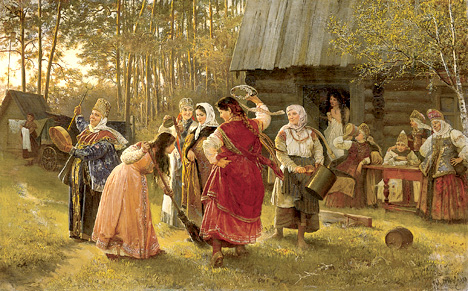
Masterpieces of the State Russian Museum from Late 18th Century to Early 20th Century (what a title!) may the the summer sleeper of museum exhibits. I went to the opening yesterday (courtesy of my friend, again!) not quite sure what to expect. I find that the Tokyo Metropolitan Art Museum generally bites - its rental galleries are often full of art club exhibitions.
But this exhibit was good. Well-documented and organised, the exhibition takes you from classical paintings in the time of Catherine II through later portraiture of “regular people” into the dark depressing times of poverty and Dostoevsky and back into the light with bold colors of the early 20th century.
There are heroic ocean storms, humorous insights into village life (Hen Party was a favorite), and heart-string tuggers of ragged beggars. If you pay attention, you get an overview not only of the changing style of art, but the changing lives of Russians during this period.
And at the end of the gallery walk, you’ll find a shop that sells Russian breads made in Yokohama. Needless to say, I bought some. How can I pass up bread?
This show runs through July 8th at the Tokyo Metropolitan Art Museum, Ueno. There’s a theremin concert on May 12th. Maybe I’ll see you there?
In looking for potential new abodes, I have considered buying an apartment in a yet-to-be constructed building. Places like this put out advance notification, set up model rooms to show off their plans and generally give prospects the idea that their new building is going to be a great place to live.
A few months ago, I saw the advance notice for a building in Rokubancho, near Yotsuya and Ichigaya stations. It fit the requirements I was looking for so I put my name on the mailing list and waited for the model room to open. Yesterday we paid a visit to the Marubeni Grand Suite Rokubancho showroom.
We sat down with an agent, Sakata-san, and told him our budget and wishes. He pulled out the building plans and showed us an apartment that was not quite 50% more than the price we’re willing to pay. The apartment he wanted us to consider would cost 1.25 million dollars. Too expensive but we toured the model room anyway, getting a feel for what that level of luxury would include.
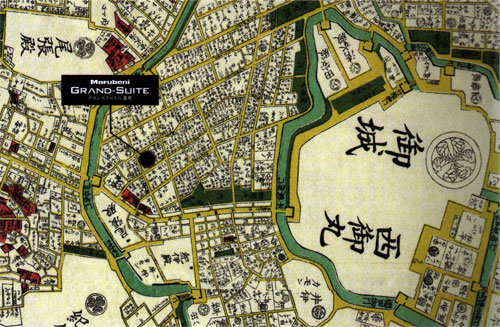
A new building on an old map
First of all, it pays for the address. This is a prestigious neighborhood a stone’s throw from the Palace and within the outer moat. Next door to the new building is an elementary school the Imperial family has used. There is history all around. These are things, Sakata-san assured us, that Japanese people will pay more for. OK but what about the building itself?
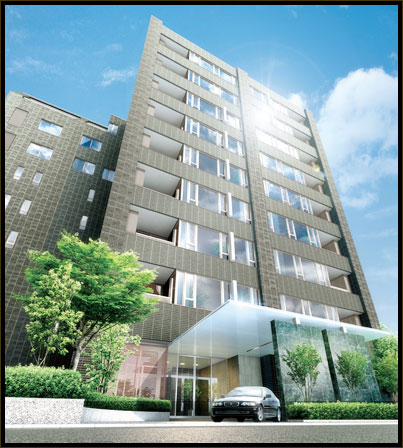
Concept drawing of the exterior
It is nine stories with views towards the moat (all taken) roof balconies (all taken) and southern exposures (all taken). There is triple security into the building beginning with a key that recognises its lock and automatically parts the outer sliding doors. And of course, the building construction is earthquake resistant.
The public spaces are decorated in rich woods and marble. In addition to a lounge area, there is a concierge desk where you can arrange package deliveries, tickets and even have lightbulbs and batteries sent up to your apartment. I don’t think I’d want to live in a place where people where too lazy to walk to the conbini for batteries.

Layout 100A. Click for larger view.
This is the room layout that was suggested to us. It’s about 100 sq meters (1076 sq ft) with two bedrooms, a coat closet and a storage room/pantry. It’s a fair size, but the layout is awkward. Look at the toilet in relation to the bedroom: you’d have to walk through your closet to the hall and nearly to the genkan before you could pee. Imagine doing that if you’re not feeling well. This is a middle apartment, so the windows are only on one side - east. Morning light only.

Detailed legend, translated. Click for larger version.
Check out the detail on the legend. It lists every outlet, light fixture, remote control. I’ve relabelled it all in English so you can see what level of detail you buy in a luxury apartment.
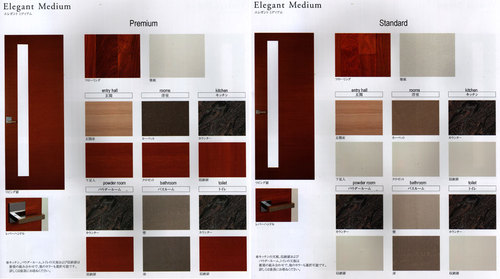
Premium and Standard versions of the medium brown colors
The apartments have many options and at a minimum level, you must choose among three color schemes (Brilliant Natural, Elegant Medium and Vintage Brown) in Standard and Premium levels. Premium has more wood; Standard uses shiny white finishes. The Premium carpets and wallpapers are a lot nicer and door handles have face plates.
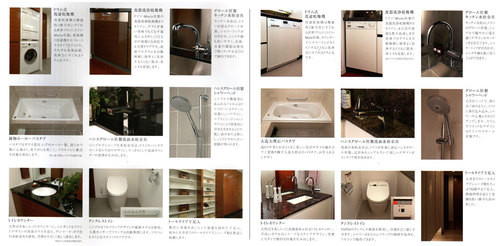
Included equipment and fixtures (Premium and Standard). Click for larger version.
The fixtures differ between the Premium and Standard apartments, too. Premium apartments have beautiful faucet handles, a larger dishwasher, separate washer/dryer, and more holes in the shower head. And note that in the photos, the Standard options have a single stem of greenery, where the Premium photos show big, bushy plants. Subtle but effective upselling.
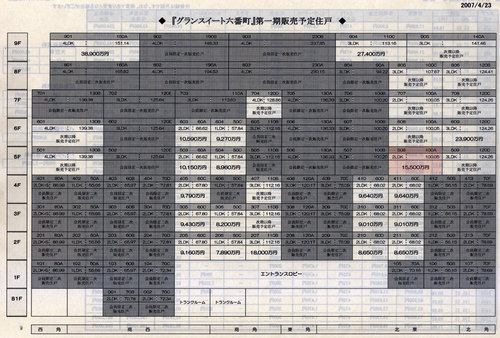
The price list mapped onto the building. Click for larger view.
And in the end, applying for an apartment doesn’t guarantee you’ll get one. After the first sales period deadline next month, they will hold a lottery to see who will get to buy the units that were on offer. Then the slate is wiped clean and another sales period begins for the remaining units.
On the map above, the rooms marked with prices are available to the public now (the red one is what we were recommended). The ones without prices will be sold in the next round. The grey ones are reserved for “members” during the first and second sales periods.
This is definitely not where we will be living. But I’m glad we went and saw the model room. Now we have another data point to compare. I still think we need to buy land and build a house.

